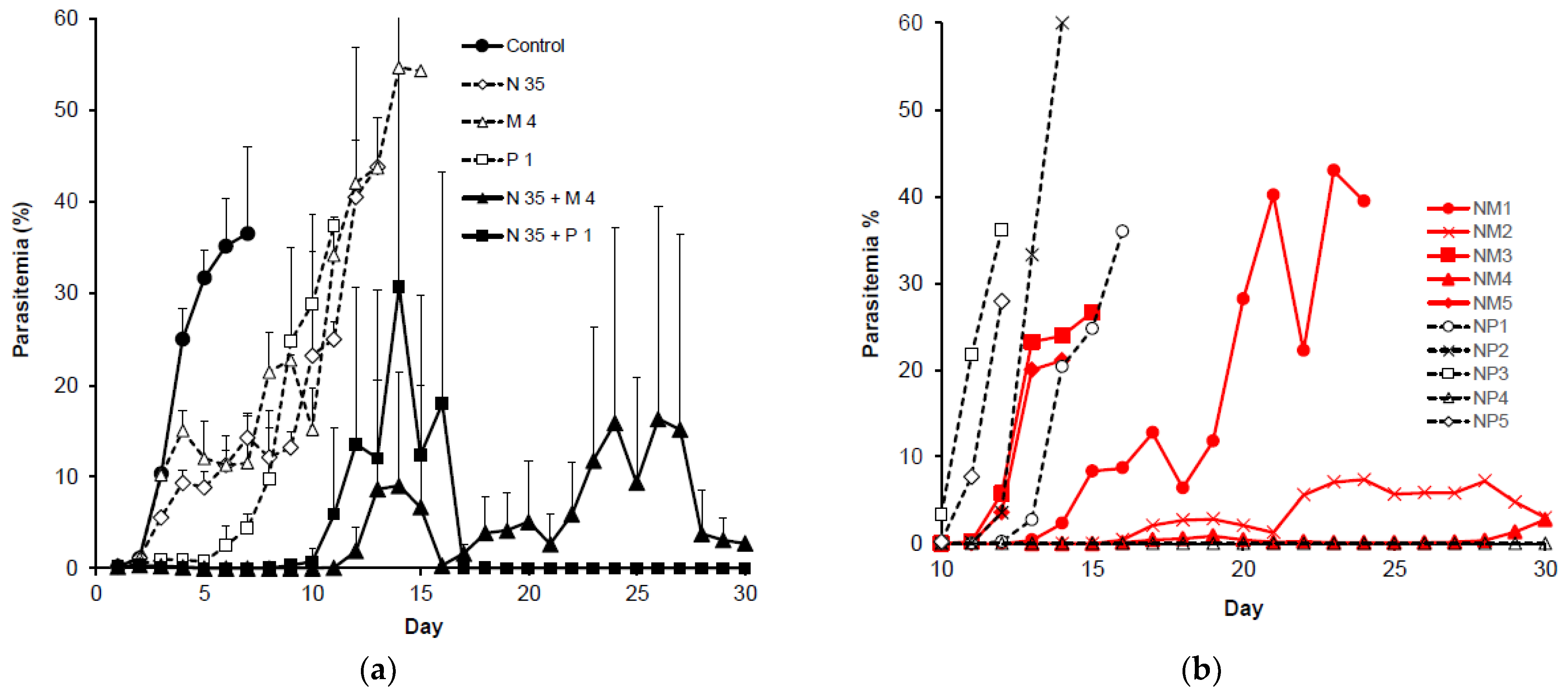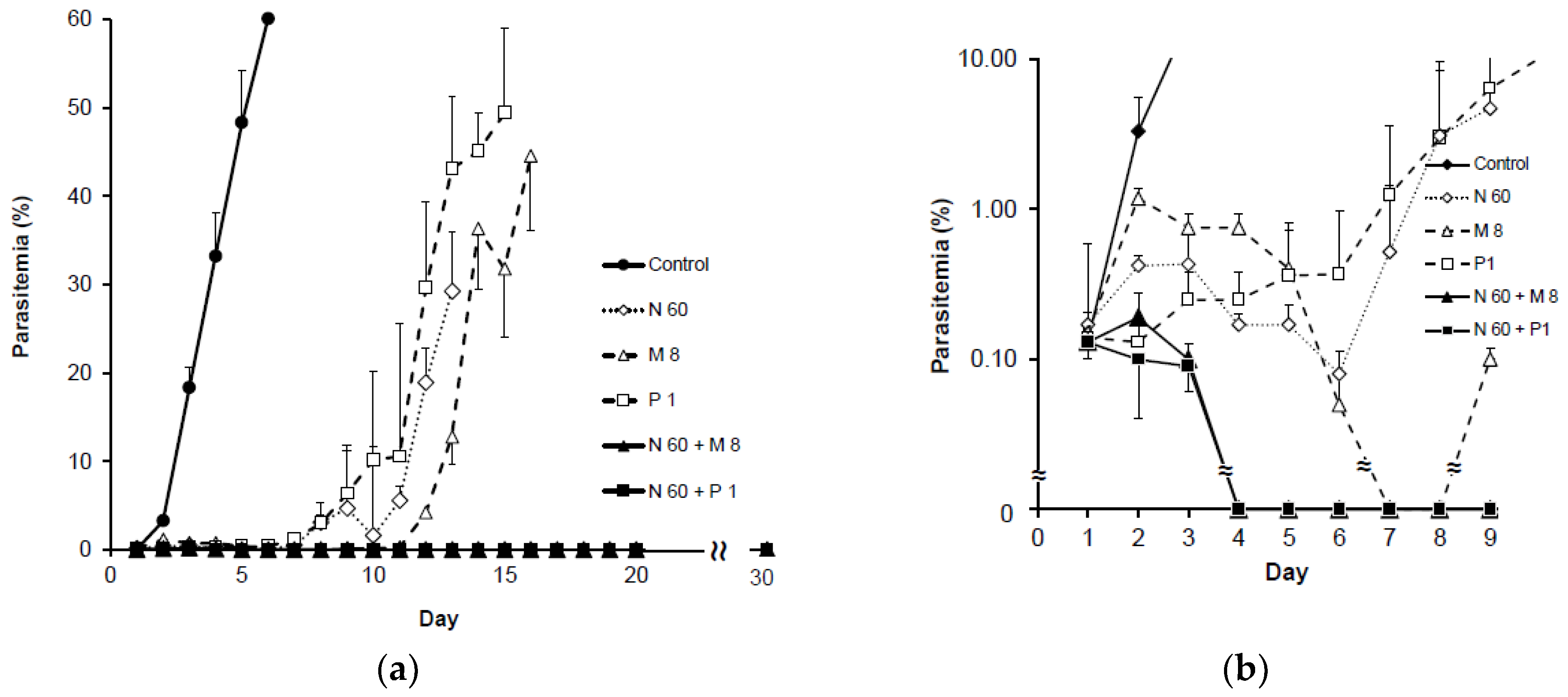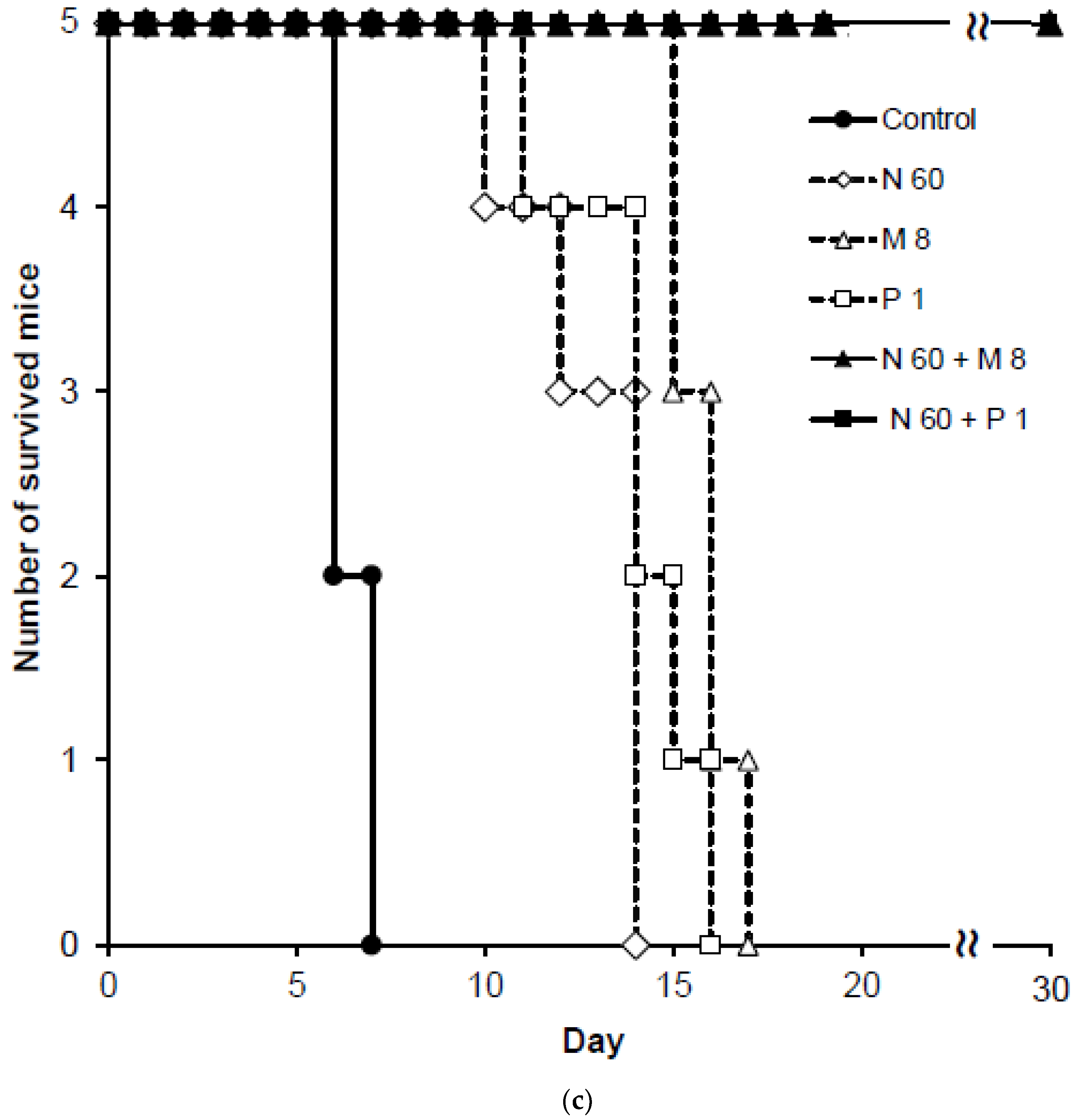Pioneer Use of Antimalarial Transdermal Combination Therapy in Rodent Malaria Model
Abstract
1. Introduction
2. Materials and Methods
2.1. Compounds
2.2. Parasites and Mice
2.3. Preparation of Transdermal Antimalarial Formula
2.4. Td antimalarial Activity and Combination Interaction Assay In Vivo
2.5. Antimalarial Activity and Cure Effect of Transdermal Combination Therapy
2.6. Statistical Analysis
3. Results
3.1. Td Antimalarial Activity and Combination Interaction Assay in Vivo
3.2. Antimalarial Activity and Cure Effect of Combined Td Drug Application
4. Discussion
Author Contributions
Funding
Institutional Review Board Statement
Informed Consent Statement
Data Availability Statement
Acknowledgments
Conflicts of Interest
References
- World Health Organization (WHO). World Malaria Report; World Health Organization: Geneva, Switzerland, 2021; Available online: https://www.who.int/publications/i/item/9789240040496 (accessed on 6 December 2021).
- World Health Organization (WHO). Guidelines for the Treatment of Malaria; World Health Organization: Geneva, Switzerland, 2006. [Google Scholar]
- Imwong, M.; Suwannasin, K.; Kunasol, C.; Sutawong, K.; Mayxay, M.; Rekol, H.; Smithuis, F.M.; Hlaing, T.M.; Tun, K.M.; van der Pluijm, R.W.; et al. The spread of artemisinin-resistant Plasmodium falciparum in the Greater Mekong subregion: A molecular epidemiology observational study. Lancet Infect. Dis. 2017, 17, 491–497. [Google Scholar] [CrossRef] [PubMed]
- Dormoi, J.; Amalvict, R.; Gendrot, M.; Pradines, B. Methylene Blue-Based Combination Therapy with Amodiaquine Prevents Severe Malaria in an Experimental Rodent Model. Pharmaceutics 2022, 14, 2031. [Google Scholar] [CrossRef] [PubMed]
- Shuto, S.; Minakawa, N.; Niizuma, S.; Kim, H.-S.; Wataya, Y.; Matsuda, A. New neplanocin analogs 12. An alternative synthesis of (6′R)-6′-C- methylneplanocin A (RMNPA), a novel potent anti-malarial agent. J. Med. Chem. 2002, 45, 748–751. [Google Scholar] [CrossRef] [PubMed]
- Kim, H.-S.; Shibata, Y.; Wataya, Y.; Tsuchiya, K.; Masuyama, A.; Nojima, M. Synthesis and antimalarial activity of cyclic peroxides, 1,2,4,5,7-pentoxocanes and 1,2,4,5-tetroxanes. J. Med. Chem. 1999, 42, 2604–2609. [Google Scholar] [CrossRef] [PubMed]
- Tsuchiya, K.; Hamada, Y.; Masuyama, A.; Nojima, M.; McCullough, K.J.; Kim, H.-S.; Shibata, Y.; Wataya, Y. Synthesis, crystal structure and anti-malarial activity of novel spiro-1,2,4,5-tetraoxacycloalkanes. Tetrahedron Lett. 1999, 40, 4077–4080. [Google Scholar] [CrossRef]
- Miyaoka, H.; Shimomura, M.; Kimura, H.; Yamada, Y.; Kim, H.-S.; Wataya, Y. Antimalarial activity of kalihinol A and new relative diterpenoids from the okinawan sponge, Acanthella sp. Tetrahedron 1998, 54, 13467–13474. [Google Scholar] [CrossRef]
- Kim, H.-S.; Nagai, Y.; Ono, K.; Begum, K.; Wataya, Y.; Hamada, Y.; Tsuchiya, K.; Masuyama, A.; Nojima, M.; McCullough, K.J. Synthesis and antimalarial activity of novel medium-sized 1,2,4,5-tetraoxacycloalkanes. J. Med. Chem. 2001, 44, 2357–2361. [Google Scholar] [CrossRef]
- Aly, N.S.M.; Hiramoto, A.; Sanai, H.; Hiraoka, O.; Hiramoto, K.; Kataoka, H.; Wu, J.-M.; Masuyama, A.; Nojima, M.; Kawai, S.; et al. Proteome analysis of new antimalarial endoperoxide against Plasmodium falciparum. Parasitol Res. 2007, 100, 1119–1124. [Google Scholar] [CrossRef]
- Morita, M.; Sanai, H.; Hiramoto, A.; Sato, A.; Hiraoka, O.; Sakura, T.; Kaneko, O.; Masuyama, A.; Nojima, M.; Wataya, Y.; et al. Plasmodium falciparum endoplasmic reticulum-resident calcium binding protein is a possible target of synthetic antimalarial endoperoxides, N-89 and N-251. J. Proteome Res. 2012, 11, 5704–5711. [Google Scholar] [CrossRef]
- Rojekar, S.; Vora, L.K.; Tekko, I.A.; Volpe-zanutto, F.; Mccarthy, H.O.; Vavia, P.R.; Donnelly, R.F. Etravirine-loaded dissolving microneedle arrays for long-acting delivery Eur. J. Pharm. Biopharm. 2021, 165, 41–51. [Google Scholar] [CrossRef]
- Paredes, A.J.; McKenna, P.E.; Ramöller, I.K.; Naser, Y.A.; Volpe-Zanutto, F.; Li, M.; Abbate, M.T.A.; Zhao, L.; Zhang, C.; Abu-Ershaid, J.M.; et al. Microarray Patches: Poking a Hole in the Challenges Faced When Delivering Poorly Soluble Drugs. Adv. Funct. Mater. 2021, 31, 2005792. [Google Scholar] [CrossRef]
- Shen, S.; Liu, S.-Z.; Zhang, Y.; Du, M.-B.; Liang, A.-H.; Song, L.-H.; Ye, Z.-G. Compound antimalarial ethosomal cataplasm: Preparation, evaluation, and mechanism of penetration enhancement. Int. J. Nanomed. 2015, 10, 4239–4253. [Google Scholar] [CrossRef] [PubMed]
- Sibiya, H.P.; Mabandla, M.V.; Musabayane, C.T. The Effects of Transdermally Delivered Oleanolic Acid on Malaria Parasites and Blood Glucose Homeostasis in P. berghei-Infected Male Sprague-Dawley Rats. PLoS ONE 2016, 11, 0167132. [Google Scholar] [CrossRef] [PubMed]
- Peters, W. The chemotherapy of rodent malaria, XXII. The value of drug-resistant strains of P. berghei in screening for blood schizontocidal activity. Ann. Trop. Med. Parasitol. 1975, 69, 155–171. [Google Scholar] [CrossRef]
- Kim, H.-S.; Miyake, H.; Arai, M.; Wataya, Y. A potent antimalarial activity of 5-fluoroorotate in combination with sulfamonomethoxine against Plasmodium falciparum in vitro and Plasmodium berghei in mice. Parasitol. Int. 1998, 47, 59–67. [Google Scholar] [CrossRef]
- Desgrouas, C.; Dormoi, J.; Chapus, C.; Ollivier, E.; Parzy, D.; Taudon, N. In vitro and in vivo combination of cepharanthine with anti-malarial drugs. Malar. J. 2014, 13, 90. [Google Scholar] [CrossRef]
- Daubrey-Potey, T.; Adjogoua, V.; Kamagaté, M.; Aoussi, S.; Dosso, M. Artemisinin-based combination therapy synergized with medicinal plants to induce musculotoxic effects. Evid. -Based Complement. Altern. Med. 2021, 2021, 8861574. [Google Scholar] [CrossRef]
- Fule, R.; Dhamecha, D.; Maniruzzaman, M.; Khale, A.; Amin, P. Development of hot melt co-formulated antimalarial solid dispersion system in fixed dose form (ARLUMELT): Evaluating amorphous state and in vivo performance. Int. J. Pharm. 2015, 496, 137–156. [Google Scholar] [CrossRef]
- Volpe-Zanutto, F.; Fonseca-Santos, B.; McKenna, P.E.; Paredes, A.J.; Dávila, J.L.; McCrudden, M.T.C.; Tangerina, M.M.P.; Figueiredo, M.C.; Vilegas, W.; Brisibe, A.; et al. Novel transdermal bioadhesive surfactant-based system for release and solubility improvement of antimalarial drugs artemether-lumefantrine. Biomed. Mater. 2021, 16, 065015. [Google Scholar] [CrossRef]
- Paudel, K.S.; Milewski, M.; Swadley, C.L.; Brogden, N.K.; Ghosh, P.; Stinchcomb, A.L. Challenges and opportunities in dermal/transdermal delivery. Ther. Deliv. 2010, 1, 109–131. [Google Scholar] [CrossRef]
- Karunajeewa, H.A.; Reeder, J.; Reeder, J.; Lorry, K.; Dabod, E.; Hamzah, J.; Page-Sharp, M.; Chiswell, G.M.; Ilet, K.F.; Davis, T. Artesunate suppositories versus intramuscular artemether for treatment of severe malaria in children in Papua New Guinea. Antimicrob. Agents Chemother. 2006, 50, 968–974. [Google Scholar] [CrossRef] [PubMed]
- Fanello, C.; Hoglund, R.M.; Lee, S.J.; Kayembe, D.; Ndjowo, P.; Kabedi, C.; Badjanga, B.B.; Niamyim, P.; Tarning, J.; Woodrow, C.; et al. Pharmacokinetic Study of Rectal Artesunate in Children with Severe Malaria in Africa. Antimicrob. Agents Chemother. 2021, 65, e02223-20. [Google Scholar] [CrossRef]
- Wong, W. The antimalarial Mefloquine targets the Plasmodium falciparum 80S ribosome to inhibit protein synthesis. Nat. Microbiol. 2017, 2, 17031. [Google Scholar] [CrossRef] [PubMed]
- Fernández-Villa, D.; Aguilar, M.R.; Rojo, L. Folic Acid Antagonists: Antimicrobial and Immunomodulating Mechanisms and Applications. Int. J. Mol. Sci. 2019, 20, 4996. [Google Scholar] [CrossRef] [PubMed]
- Jang, H.-J.; Shin, C.Y.; Kim, K.-B. Safety evaluation of polyethylene glycol (PEG) compounds for cosmetic use. Toxicol. Res. 2015, 31, 105–136. [Google Scholar] [CrossRef] [PubMed]
- Fruijtier-Pölloth, C. Safety assessment on polyethylene glycols (PEGs) and their derivatives as used in cosmetic products. Toxicology 2005, 214, 1–38. [Google Scholar] [CrossRef]
- Zhang, Y.; Lane, M.E.; Moore, D.J. An Investigation of the Influence of PEG 400 and PEG-6-Caprylic/Capric Glycerides on Dermal Delivery of Niacinamide. Polymers 2020, 4, 2907. [Google Scholar] [CrossRef]
- Aly, N.S.; Matsumori, H.; Dinh, T.Q.; Sato, A.; Miyoshi, S.-I.; Chang, K.-S.; Yu, H.S.; Kim, H.-S. Formulation and evaluation of the antimalarial N-89 as a transdermal drug candidate. Parasitol. Int. 2023, 93, 102720. [Google Scholar] [CrossRef]






| Compounds | ED50 (mg/kg) | ED90 (mg/kg) |
|---|---|---|
| N-89 | 18.0 ± 2.0 | 42.0 ± 3.2 |
| Mefloquine | 3.0 ± 0.7 | 5.5 ± 0.2 |
| Pyrimethamine | 0.1 ± 0.5 | 0.4 ± 0.1 |
| Chloroquine | 3.0 ± 0.3 | 6.4 ± 0.1 |
| Parasitemia (%) | ||||||
| Compounds | Day 1 | Day 4 | Day 7 | Day 9 | Day 15 | Day 30 |
| Control | 0.18 ± 0.02 | 25.04 ± 3.3 | 36.58 ± 9.43 | - | - | - |
| N-89 | 0.23 ± 0.06 | 9.31 ± 1.36 a | 14.29 ± 2.4 a | 13.16 ± 1.77 | - | - |
| Mefloquine | 0.20 ± 0.03 | 15.30 ± 2.18 a, b | 11.51 ± 5.43 a | 22.75 ± 0.59 c, d | 54.33 | - |
| Pyrimethamine | 0.21 ± 0.04 | 0.90 ± 0.42 a, b, c | 4.39 ± 1.59 a, b | 24.81 ± 10.21 b | - | - |
| N-89 + mefloquine | 0.19 ± 0.03 | 0.12 ± 0.04 a, b, c | 0 a, b, c, d | 0 b, c, d | 6.67 ± 13.30 c | 2.74 ** |
| N-89 + pyrimethamine | 0.17 ± 0.02 | 0.10 ± 0.05 a, b, c | 0 a, b, c, d | 0 b, c, d | 12.36 ± 17.47 c | 0 *** |
| p-value * | 0.2 | <0.001 | <0.001 | <0.001 | 0.8 | |
| Parasitemia (%) | ||||||
| Compounds | Day 1 | Day 4 | Day 7 | Day 9 | Day 15 | Day 30 |
| Control | 0.13 ± 0.01 | 33.20 ± 4.94 | - | - | - | - |
| N-89 | 0.17 ± 0.03 | 0.17 ± 0.03 a | 0.52 ± 0.93 | 4.69 ± 10.02 | - | - |
| Mefloquine | 0.15 ± 0.03 | 0.75 ± 0.19 a | 0 b | 0.11 ± 0.03 b | 31.80 ± 8.37 | - |
| Pyrimethamine | 0.14 ± 0.02 | 0.25 ± 0.13 a | 1.24 ± 2.39 | 6.38 ± 9.98 | 49.36 | - |
| N-89 + mefloquine | 0.13 ± 0.03 | 0 a | 0 b, d | 0 b, c, d | 0 c, d | 0 ** |
| N-89 + pyrimethamine | 0.13 ± 0.03 | 0 a | 0 b, d | 0 b, c, d | 0 c, d | 0 ** |
| p-value * | 0.1 | <0.001 | <0.001 | <0.001 | 0.001 | |
| Compounds | Survival (Day) Low Dose * | Survival (Day) High Dose ** |
| Control | 6.6 ± 2.3 | 6.4 ± 2.6 |
| N-89 | 14.2 ± 2.3 | 12.8 ± 4.7 |
| Mefloquine | 12.2 ± 3.5 | 15.8 ± 7.2 |
| Pyrimethamine | 10.8 ± 4.2 | 14 ± 5.7 |
| N-89 + mefloquine | 23.8 ± 3.0 | >30.0 *** |
| N-89 + pyrimethamine | 17.6 ± 5.5 | >30.0 *** |
Disclaimer/Publisher’s Note: The statements, opinions and data contained in all publications are solely those of the individual author(s) and contributor(s) and not of MDPI and/or the editor(s). MDPI and/or the editor(s) disclaim responsibility for any injury to people or property resulting from any ideas, methods, instructions or products referred to in the content. |
© 2023 by the authors. Licensee MDPI, Basel, Switzerland. This article is an open access article distributed under the terms and conditions of the Creative Commons Attribution (CC BY) license (https://creativecommons.org/licenses/by/4.0/).
Share and Cite
Aly, N.S.M.; Matsumori, H.; Dinh, T.Q.; Sato, A.; Miyoshi, S.-I.; Chang, K.-S.; Yu, H.S.; Cao, D.T.; Kim, H.-S. Pioneer Use of Antimalarial Transdermal Combination Therapy in Rodent Malaria Model. Pathogens 2023, 12, 398. https://doi.org/10.3390/pathogens12030398
Aly NSM, Matsumori H, Dinh TQ, Sato A, Miyoshi S-I, Chang K-S, Yu HS, Cao DT, Kim H-S. Pioneer Use of Antimalarial Transdermal Combination Therapy in Rodent Malaria Model. Pathogens. 2023; 12(3):398. https://doi.org/10.3390/pathogens12030398
Chicago/Turabian StyleAly, Nagwa S. M., Hiroaki Matsumori, Thi Quyen Dinh, Akira Sato, Shin-Ichi Miyoshi, Kyung-Soo Chang, Hak Sun Yu, Duc Tuan Cao, and Hye-Sook Kim. 2023. "Pioneer Use of Antimalarial Transdermal Combination Therapy in Rodent Malaria Model" Pathogens 12, no. 3: 398. https://doi.org/10.3390/pathogens12030398
APA StyleAly, N. S. M., Matsumori, H., Dinh, T. Q., Sato, A., Miyoshi, S.-I., Chang, K.-S., Yu, H. S., Cao, D. T., & Kim, H.-S. (2023). Pioneer Use of Antimalarial Transdermal Combination Therapy in Rodent Malaria Model. Pathogens, 12(3), 398. https://doi.org/10.3390/pathogens12030398







